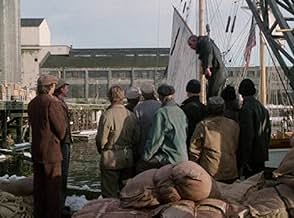Inspired by the famous 1897 editorial that has become a holiday staple, Yes Virginia, There Is A Santa Claus tells the story of young Virginia O'Hanlan and the newspaper man who answered her... Read allInspired by the famous 1897 editorial that has become a holiday staple, Yes Virginia, There Is A Santa Claus tells the story of young Virginia O'Hanlan and the newspaper man who answered her question.Inspired by the famous 1897 editorial that has become a holiday staple, Yes Virginia, There Is A Santa Claus tells the story of young Virginia O'Hanlan and the newspaper man who answered her question.
- Virginia O'Hanlon
- (as Katherine Isobel)
- Teddy O'Hanlan
- (as Shawn MacDonald)
- Director
- Writers
- All cast & crew
- Production, box office & more at IMDbPro
Storyline
Did you know
- TriviaIn the movie, Yes Virginia, There Is A Santa Claus (1991), Charles Bronson plays a man struggling with the death of his beloved wife. In real life, he himself was in mourning, having lost his wife, Jill Ireland, the year before in 1990.
- GoofsThe real Francis P. Church only married after the publication of the "Yes, Virginia" letter in 1897, and had no children.
- Quotes
Andrea Borland: Did you like my story on the Vanderbilt ball?
Edward P. Mitchell: I printed it, didn't I?
Andrea Borland: Well, half of it.
Edward P. Mitchell: That was the half I liked.
- ConnectionsReferenced in Night Court: Party Girl: Part 1 (1992)
This is a TV movie about that event. The essential details are true, and the main characters are real. But the story in this film is mostly fictional. Yet it works to make a fuller and more meaningful plot; and, therefore, a better Christmas movie.
The film was shot in British Columbia, Canada. The scenes and settings seem to be authentic for 1890s New York or any North American city at the time. The cast has some big name actors and others - all of whom give very good performances. Katharine Isabelle is superb as Virginia O'Hanlon. Tamsin Kelsey is especially good as Evie O'Hanlon, wife of James. She plays an Irish immigrant woman who keeps a bright outlook for her small brood, in spite of the hard times.
The portrayal of hard times for immigrants adds some meat and meaning to the story. Richard Thomas plays Virginia's father, James. He and his friend, Donelli, spend cold days looking for work after being fired as dockworkers. The story gives a light portrayal of the ethnic tensions of the time. During the immigration of many Irish, Anglo-Protestants resented their competition for jobs. And, neighbors in tenement apartments help one another, by sharing food. A Jewish landlady widow, Mrs. Goldstein (played by Lillian Carlson) cooks too much brisket for just herself, so she begs the O'Hanlon's to take it off her hands.
Charles Bronson is very good in his role as Francis Church. But the character he plays was not the real Francis Church. Here, Church has been drinking heavily since losing his wife and daughter a year earlier. The film doesn't say, but it's implied it was a disease or epidemic. That's another nice touch in showing that aspect of history in the late 19th and early 20th centuries. The real Frank Church was in his 50s and had covered the Civil War more than 30 years earlier.
It's true that Church didn't want to write the editorial, and didn't want his name associated with it. Only many years later was his authorship of the article made known. Even then, one wonders, because Church was supposedly an atheist. Yet he wrote in that editorial, "No Santa Claus! Thank God! He lives, and he lives forever." That's hardly something an atheist would write, and it's not very likely that he would have had to write that.
Edward Asner plays another real person well -- Edward P. Mitchell, the managing editor. Other reporters and people on the Sun staff are fictional. Yet Colleen Winton plays Andrea Borland very well, and Shawn Macdonald plays the copy boy, Teddy, very well.
The biggest fictional aspect was Virginia's family and where they lived. They weren't likely to be living in tenement housing as in the film. Virginia's dad, James, was a doctor. At the time, he was a coroner's assistant in Manhattan.
In the movie, the editorial in response to Virginia appeared in the sun around Christmas Eve. But the actual date it was printed was Sept. 21 - three months before Christmas. In later years, Virginia explained that around her birthday in July as a child she would begin to wonder what she would be getting for Christmas. So, she wrote her letter in July. And, the Sun editors didn't do anything with it for several weeks. And no one knows why they didn't wait until Christmas to publish it.
Even then, the article wasn't considered anything special at the time. But readers remembered and asked about it in subsequent years. So, more than 10 years after its first publication, the Sun again printed the article just before Christmas.
The story about the famous letter and Sun newspaper editorial is an endearing one. And the filmmaker's embellishment of the story helps make "Yes Virginia" a wonderful Christmas movie and look at history.
Here are a couple favorite lines from this film.
Andrea Borland, "Did you like my story on the Vanderbilt ball?" Edward Mitchell, "I printed it, didn't I?" Andrea Borland, "Well, half of it." Edward Mitchell: "That was the half I liked."
Mrs. Goldstein, "As my dear dead Saul used to say, 'It isn't a silver lining what makes the coat. It's the person wearing it.'"
Details
- Release date
- Countries of origin
- Language
- Also known as
- Так, Вірджиніє, Санта Клаус існує
- Filming locations
- Production companies
- See more company credits at IMDbPro
Contribute to this page


































